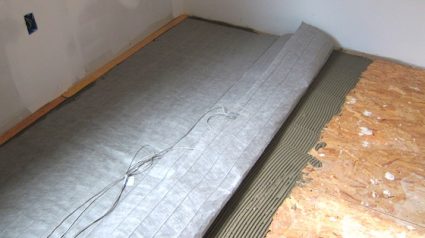How to Stay Warm in Cold Weather

The gray fabric mat contains electric heating cables. Finished flooring is installed on top of the mat after it’s covered with a thin coat of sand and cement. It’s but one way to keep your feet warm. Copyright 2024 Tim Carter
How to Stay Warm in Bitter Cold Weather - It's So Easy
You may be one of the tens of millions of folks like me that live where it gets cold in the winter. If you’re blessed to live in the south or southwest, I do know there can be some cold waves that force you to put on a sweater. With inflation raging out of control, it’s so very important to spend the least amount of money to be comfortable. I can help you do just that.
To be honest, I could write a book about this topic. I know I’ll get emails about leaving this or that idea out of this column. Right now I’m going to serve up to you slices of juicy low-hanging fruit. Let’s get started.
As crazy as this sounds, the easiest way to save money and stay toasty warm inside your home is to wear more clothes and turn down your thermostat. I do this each winter. I’ll wear flannel-lined jeans and sometimes insulated coveralls. It’s not uncommon to find me donning a hoodie sweatshirt. I often put the hood up to keep my head and neck warm. I wear wool socks. You may think this is nuts, but when I’m dressed like this indoors I’m toasty warm with my thermostat set between 62 and 65 F.
Think about how you can compress your lifestyle in the winter. Can you close off rooms and just direct your heating to a few rooms instead of your entire house? If you were lucky enough to have a zoned heating system installed, it’s easy to send heat to the rooms you live and sleep in as well as the rooms that have plumbing water lines that must remain above 35 F to prevent them from bursting.
Several years ago I converted some attic space above my garage to a man cave. I decided to heat it using a fiberglass mat that has electric cables built into it. The mat was custom designed at no extra cost to match the size of the room and the heat loss of my space. It’s vital you do this. If my man cave was in southern Tennessee instead of central New Hampshire, far fewer cables would have been installed in the mat.
Another simple way to take the chill off a room is to use an oil-filled portable electric radiator. I’ve tested several that cost less than $100 and they do a remarkable job of heating an unheated space. Many of these are programmable so you can turn them down when you’re not in the space. Then, have them turn on magically 90 minutes before you come into the room so it’s up to temperature.
The largest source of heat loss in the average home is air infiltration. Check all your doors and windows to make sure they’re locked. Locking them pulls the sash tight against the weatherstripping.
If air is leaking under a door, consider using a felt weatherstrip that attaches to the bottom of the door with small nails, screws, or adhesive tape. You have the skill to install this in minutes. Stopping cold drafts can significantly lower your heating costs and you won’t feel like you’re in a wind tunnel.
Keep in mind that the placement of insulation is vital to ensure all the heat produced by electric coils or radiant heat tubing is directed into the living space. Years ago while I was helping build my daughter’s new home I educated an insulation crew leader. He was the rare person that listened to me and hours later admitted he had been installing insulation wrong in hundreds of houses for over twenty years.
When he arrived at my daughter’s house to install the fiberglass batts under the radiant floor tubing he asked me, “How much air space do you want between my insulation and the tubes? We normally do 1 to 2 inches.” I responded, “I don’t want any air space. Put the insulation in direct contact with the radiant heat tubes and do whatever is necessary to ensure it never falls down.”
This middle-aged man just looked at me and said, “Okay, but we’ve never done it that way before.” I politely said, “Are you the same crew that put the insulation in the walls here? I see that there’s no air space between the warm drywall and your insulation. If an air space is so important, then why did you eliminate it in all the walls?” He just blinked at me and walked away. Hours later he came up to my son-in-law and said, “Your father-in-law taught me something. I’ve been installing insulation under radiant tubes wrong my entire career.”
The reason you want the insulation to be in contact with the tubing or the OSB subflooring under an electric mat is simple. You want to drive all the heat up into the living space. If you have an air gap, some of the heat goes down not up.
If you’re planning on building a room addition or a new home soon, you have a unique opportunity to design a zoned heating system that will allow you to keep your heating bills to a minimum. If you can’t find a pro to talk to about this, I’m happy to consult with you.
Imagine using a simple water heater to create all the heat you need for a simple room addition. I can’t begin to tell you how comfortable a floor is that’s heated by hot water. It’s dreamy heat. If you lay down on the floor, you don’t want to get up.
Column 1542